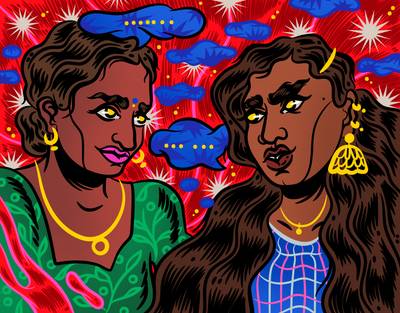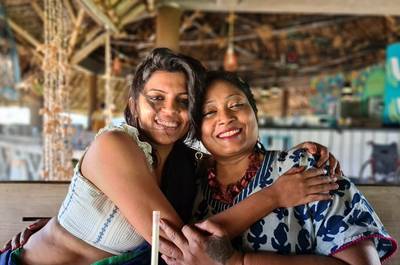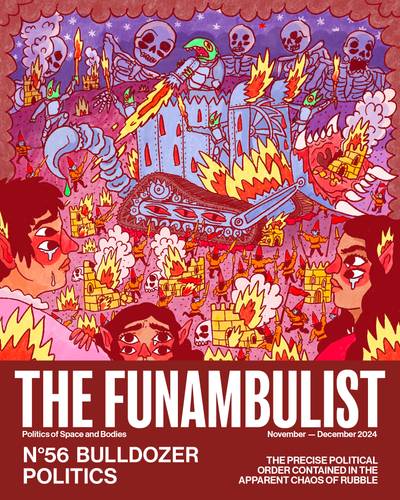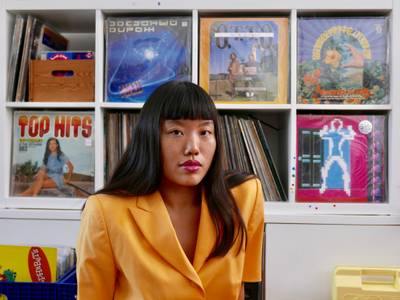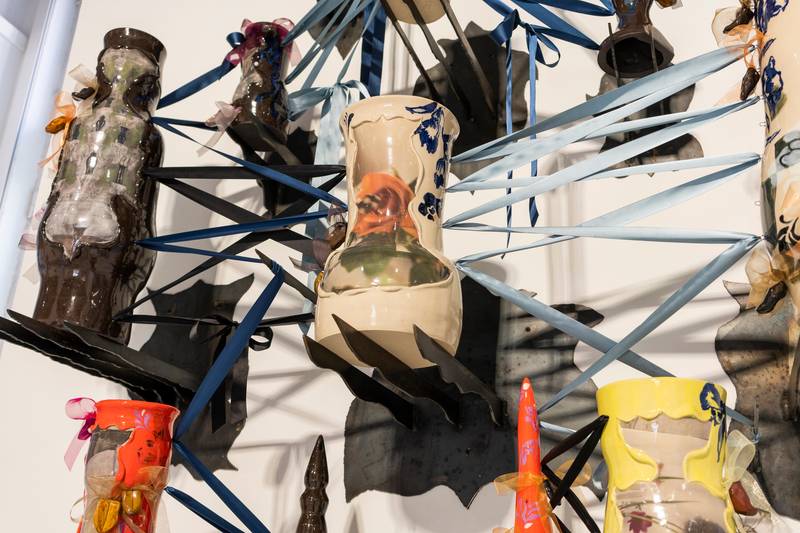

Man Yau, M.Y. Chinoiserie: Ceramic, glaze, ceramic decals (on-glaze), Baroque pearls, silk, blued steel 200 cm x 160 cm x 60 cm. Photo: Petri Summanen.
Nimco Kulmiye Hussein is a multidisciplinary writer/critic who works at the intersections of research, visual culture and art. They are the founder and co-editor of Ante Nouveau, a magazine focusing on contemporary art and culture as well as critical thinking and practices. Kulmiye Hussein holds a Master of Arts from Aalto University, School of Arts, Design and Architecture.
Craftsmanship that leaves a polished finishing and evocative historical notions hidden underneath the fine details. Man Yau’s work with ceramic installations arrests the viewer, while encouraging to revisit and contemplate the uncanny contemporaneity that the artworks embody. In this interview, we discuss artistic processes, practices and labour as well as the intertwining of the personal and the thematic in Yau’s two exhibitions from the spring 2021: M.Y. Chinoiserie at Kuvan Kevät, Exhibition Laboratory, and Dried flowers last forever at Boy Konsthall.
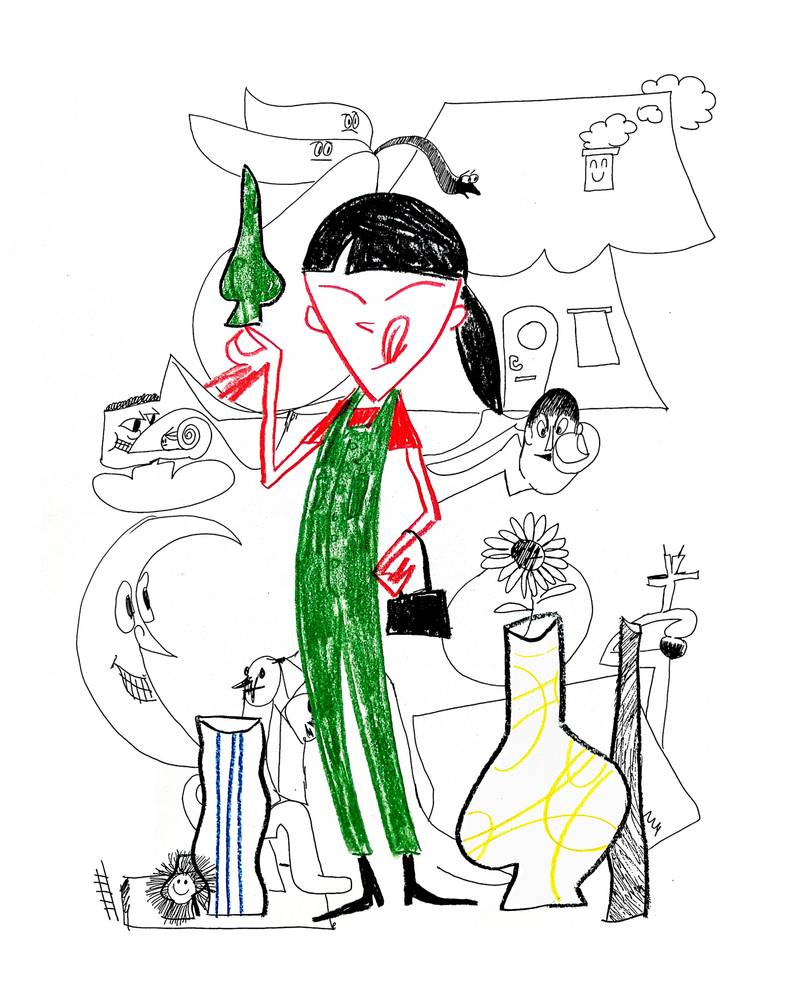

Sakari Tervo, Portrait of Man Yau, 2021
NIMCO: I have been amazed by your work and continue to be so. The impressive technique and craftsmanship needed is an astounding layer to the thematics that the works exemplify. Luckily, this spring, we have had two exhibitions featuring your work: M.Y. Chinoiserie at Kuvan Kevät/Exhibition Laboratory, and Dried flowers last forever at Boy Konsthall. Perhaps we can start by returning to the making of the artworks. What are your artistic processes like?
MAN: Lovely words! It’s great if the craft and techniques are noticed––they play a significant role in my work in general, and often certain materials and methods are also related to the artistic idea itself. In other words, specific techniques are chosen to fit the subject. The materials and craft chosen are not an end in themselves, but a means to discuss something. In the case of the exhibitions you mentioned, the materials refer to exoticisation.
As a step-by-step method, my process could be described like this: first, there is a subject or something that intrigues me for a long time. It may well be a subject that I have been thinking about for few weeks or years. Perhaps the most vital thing about choosing a subject for an artistic project is being able to work with an idea so complex that it isn’t easily translated into words. This might be a bit tacky, but you just know and feel it when you’ve found the right subject, and by right, I mean something that I feel is important and that I’m prepared to address publicly. The work of an artist is often public.
When I start the physical work, as in sculpting, the subject matter is often indefinite and obscure. I conduct many tests, such as sketches and material experiments at the beginning, along with the background work. It’s often at this stage that the final form of the work begins to take shape in my mind. For example, when I worked on the piece for Kuvan Kevät, this stage took about a year, as the subject of exoticisation, and bringing it out as a first-hand experience felt so challenging. It was vital for me to create the artwork so that it would not be interpreted as just pain or an imitation of compliance. Eventually, the form of the wall installation, with its silks and ceramic objects, took shape and I knew what I had to do.
When I start the final stage and begin working on the sculpture, it’s quite systematic. In practice, I do what I have planned and imagined in my mind at the sketch stage, and at this stage there are only minor changes. I have a wide knowledge of different materials, which makes [the process] relatively smooth and I’m usually at the studio 24/7, day and night. Perhaps, in a way, it’s the “easiest stage” if you can call it that (Laughs). I will always plan in my mind what the final installation will look like, and I test it out in my studio to make sure it works, so that when it comes to [installing] the work, it takes very little time.
Although I’m talking about the artistic [process] in terms of clear steps, the stages interconnect. It is a combination of, in a way, notions of time that are hard to pin down (first-hand experiences, historical references, the present) while sculpting feels rooted directly in the moment that you’re in.
Both exhibitions seem to overlap and intersect when it comes to material choices and the themes that draw from (art) historical styles, such as chinoiserie (the European interpretation and imitation of Chinese and other East Asian artistic traditions, especially in the decorative arts). In the email, I highlighted and extracted a sentence that you wrote to describe both exhibitions: “the feeling of being on display and under pressure”. Can you tell me more about this?
Yes, that description is sort of the starting point for both exhibitions. It’s formed into those words at the sketch stage of the process, when the visual [concept] is still vague, there’s just a sense of something [that I have] to deal with. In both exhibitions, I address exoticisation from quite a few angles. For example, by referring to historical contexts such as the Chinoiserie style and the ideals of the Baroque and Rococo periods in the eighteenth century and the popular porcelain cabinets in palaces of this time, or even [the visual exoticisation of Asian] womanhood. That phrase “the feeling of being on display and under pressure” refers to my personal experience of exoticisation. [When] certain external features are fetishized and valued as commodities, [it becomes] simultaneously something very violent and frightening - being outside of the self. And while that has been the starting point in both exhibitions, it’s also something that I try to destroy, for instance, by creating an embodied experience of collapse.
The works are full of representation of history and my personal experiences, and in a way, I trust that by observing the details of the work the viewer can get a sense of what I’m dealing with. The finished pieces in the exhibition venue, in this case, the Exhibition Laboratory or Boy Konsthall, do not themselves refer to something that is not already present. By this, I mean that my works are not illusionistic, in the usual sense of the word. No matter how the viewer experiences the works, they experience them “correctly”. For instance, a person who shares a similar position with me may recognize something familiar from their own life. At the same time, someone from a different background may not understand anything about the work. But it would be great if the work has spoken or done something for the viewer.
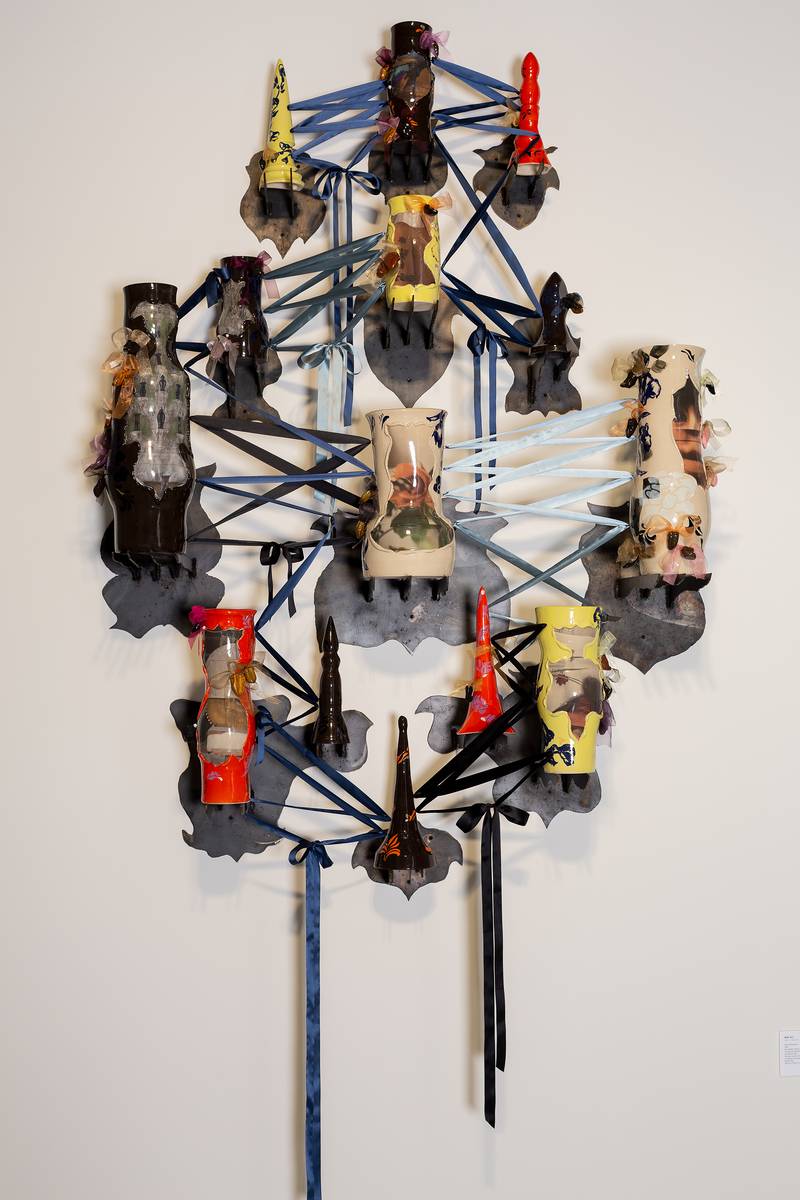

Man Yau, M.Y. Chinoiserie: Ceramic, glaze, ceramic decals (on-glaze), Baroque pearls, silk, blued steel 200 cm x 160 cm x 60 cm. Photo: Emma Sarpaniemi.
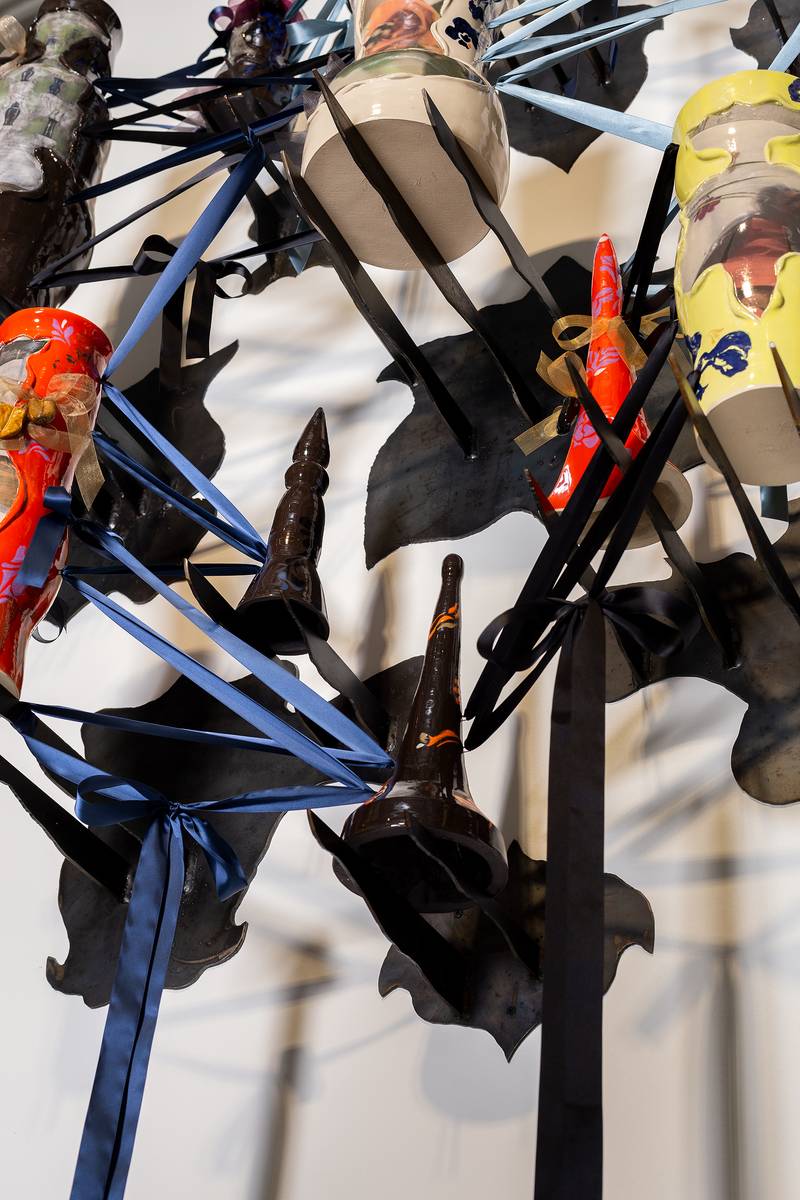

Man Yau, M.Y. Chinoiserie: Detail of the installation, 2021. Photo: Emma Sarpaniemi.
Who do you see as your primary audience? Do you think about the audience or their impact on your artistic processes (during or after)?
My audience… this one is difficult. I don’t necessarily target my work, it’s for anyone and everyone at the same time. But I think about the viewer a lot throughout the process, even after the work is finished.
As I mentioned before, the artist’s work is so often public, and I also see a lot of responsibility that the artist must take into account. It’s a privilege to be able to go into public spaces to present one’s own views, and so it would be irresponsible in every way not to think about what you’re doing. I don’t mean that my artistic process is based on the viewer, but I’m aware that there is a viewer, and the responsibility that goes with this must be kept in mind. It is crucial to recognise one’s position and power, what or who one is referring to/representing, and what kind of images one creates through one’s artistic choices.
Secondly, my artistic process is very embodied, and so for me, the bodily experience is an essential element in the work and in the final piece. I think a lot about how certain choices I make in my work feel, in a bodily sense––how it feels to look at a material that looks like it could break at any moment, or what associations a steeply high-heeled shoe may evoke.
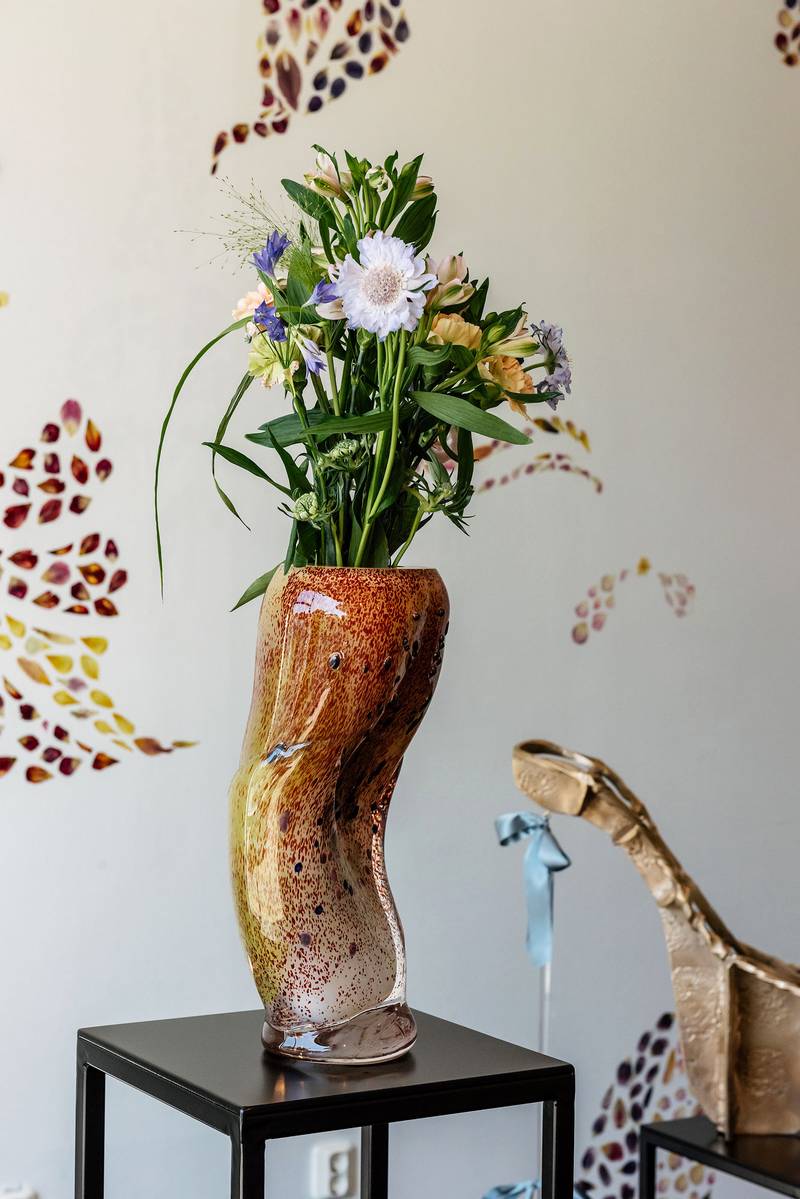

Man Yau, Ornament: Mouth-blown glass, flowers 40 x 15 x 20 cm, 2021. Photo: AnnaCarin Isaksson.
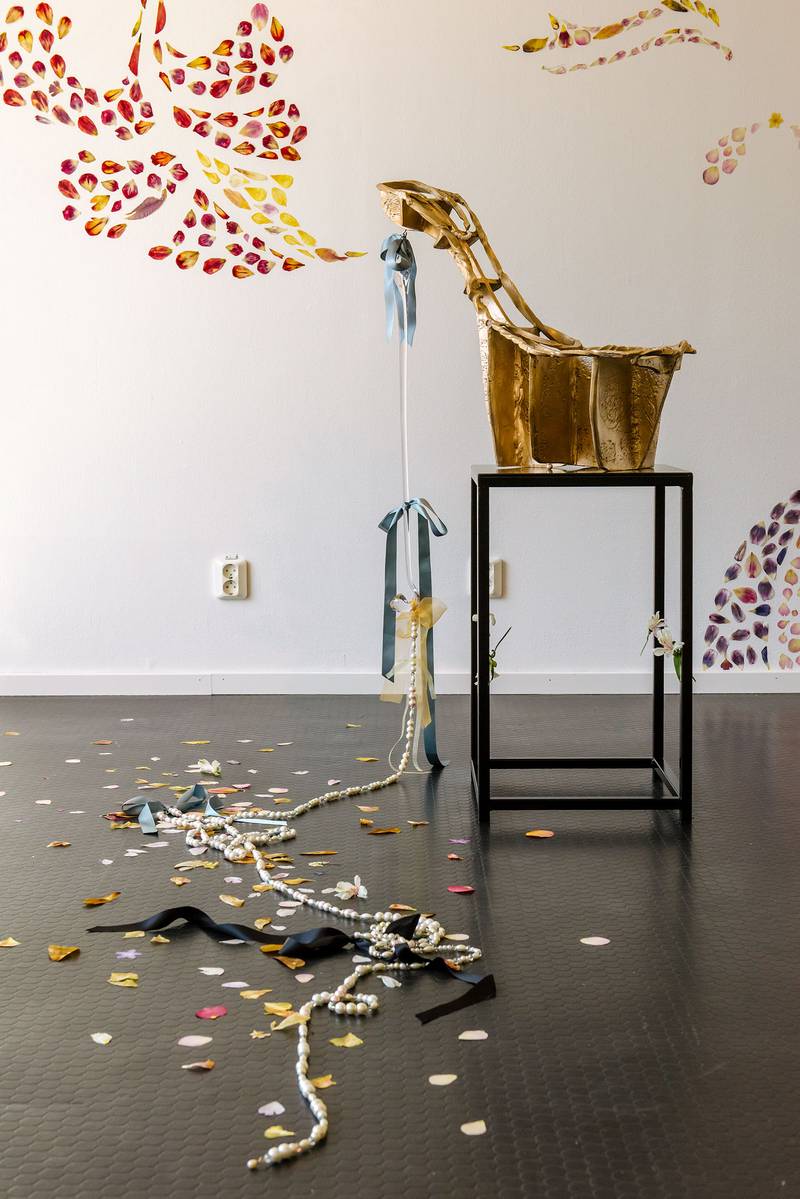

Man Yau, High Heal: Cast bronze, silver, Baroque pearls, mouth-blown glass, silk, glass beads 90 x 73 x 32 cm with a pearl heel extension of 500 cm, 2021. Photo: AnnaCarin Isaksson.
The artist’s work is so often public, and I also see a lot of responsibility that the artist must take into account. It’s a privilege to be able to go into public spaces to present one’s own views, and so it would be irresponsible in every way not to think about what you’re doing. I don’t mean that my artistic process is based on the viewer, but I’m aware that there is a viewer, and the responsibility that goes with this must be kept in mind.
So, so fascinating. You mentioned the importance of processes that relate to the body, would you like to tell me more about that? How does it manifest in the works and otherwise?
In principle, I think embodied ways of working (for me it often means slow and dedicated methods) are important, especially in an age when everything is so fast and digital, so instantaneous. It’s also for me a method of generating thought and a way of referring in a fairly straightforward way to a three-dimensional world - a place where my own body also operates. The sculpture in a space affects how you move and behave in that space. Sometimes this is quite apparent (Kuvan Kevät: deliberate placement of the work too high, too near to the edge. Boy Konsthall: the path of beads and dried plants), and sometimes this is more of a subconscious thing. It is not just a physical experience when I talk about embodiment – it can also be psychological, behavioural, emotional, and so on.
Embodiment is also related to my experiences of exoticisation, where the othering is justified by a “different” (or unequal) body. This is related to the fetishization and objectification which I mentioned earlier. For example––suppose I look at the sensations that stir when I am the object of exoticisation. In this case, they are related to embodiment, and this brings me back to the sensation of being “on display and under pressure”. In both exhibitions, the bodily effects and the way the viewer positions themselves in front of the work, and the feeling it gives them, are all related to that feeling I have described.
***You mentioned history and personal experiences, where else do you draw your references from? ***
Well, this is hard to answer in that sense because the answer to this would be “everywhere”. (Laughs)
Since I focus on rather personal views/experiences/feelings in both exhibitions, so many of the individual elements come from my environment, culture, and daily life. What I read, see (in real life and on screen), daily news, conversations with friends, what other artists have done on the same subject, as well as artists whose practice I follow. Every material used in my work is selected according to the history of that material, and the value placed on it in the West (e.g., silk, Baroque beads, ceramics, bronze). In addition, my work shows a clear link to my background in TaiK [University of Art and Design Helsinki, later became Aalto University, School of Arts, Design and Architecture], and the practice-based study I developed there during my first MA studies.
On the other hand, objects of use have always been present in my work, as I feel it is important to refer to and reference things that are recognisable and have associations with their intended use. That I see as significant in the theme I am addressing. For instance, the unused vase in the Kuvan Kevät exhibition [is] an object of value and at the same time, a reference to the modern history of art, where the emergence of women’s artistic voice and work was seen through craft.
To summarise, I make my final choices for works based on affects, which I feel is fundamental. An overly “manipulated” outcome––where all the elements are too overtly readable––is not interesting to me. Instead, it’s a matter of mixing together a sensual environment with my personal references, in order to leave room for something I can’t yet anticipate at the production stage.
Another significant challenge is money, and the general problems that come with being an artist. Money and artist’s pay should be more widely spoken about, and I also refer here to different forms of remuneration that are not just grants, because it has a lot to do with what you can get hold of––particularly as a user of rather expensive materials.
What do you find challenging? I know this sounds broad, but maybe relating specifically to labour and the production of the works.
The most challenging part of the process is often “putting yourself out there”. I used to make works (e.g., Delfu, or HER-BB) where I dealt with things through distancing, using alienation as an effect. In retrospect, it perhaps was due to fear. It feels safer if things are not directly linked to me. Now, after having acquired some experience, I have dared to dig deeper. You can learn to make yourself more vulnerable, but it’s a challenge that feels significant in my work.
Another significant challenge is money, and the general problems that come with being an artist. Money and artist’s pay should be more widely spoken about, and I also refer here to different forms of remuneration that are not just grants, because it has a lot to do with what you can get hold of––particularly as a user of rather expensive materials. (Laughs) I know many artists who have simply stopped making art because of money. However, I don’t believe in the notion that exhibitions should “become better each time”, and despite how difficult the exhibition process may be––thematically or production-wise––the exhibition is always accomplished in the end.
I mentioned to you in the first column that for our upcoming studio exhibition, Easy Fit!. [In that project] we decided to organise a funding campaign for the project ourselves in order to avoid the laborious gamble of the formal grant funding process.
Every art project has a piece of “me” in it, which inevitably includes those personal experiences. Presenting a project in an exhibition space is always challenging, but it’s really who or what you are working with that matters. For instance, how you work with the institution/gallery/curator/co-artists. The biggest importance to take into account - whether you’re creating a commissioned work for a company or a curated group show - is acknowledging that you’re working with a human being.
I definitely agree with you. Not only should labour be discussed but appreciated and actively also understood by people who are not artists themselves. There have been some campaigns that have critiqued the system of getting paid by “exposure”. Not to mention the grant lottery and the resources that go into navigating that realm. Another thing you mentioned was getting yourself out there and allowing oneself to be more vulnerable. I think this also depends on the sites in which this is happening. Have there been any particular spaces or audiences that have allowed you to exhibit certain issues more freely?
Every art project has a piece of “me” in it, which inevitably includes those personal experiences. Presenting a project in an exhibition space is always challenging, but it’s really who or what you are working with that matters. For instance, how you work with the institution/gallery/curator/co-artists. The biggest importance to take into account - whether you’re creating a commissioned work for a company or a curated group show - is acknowledging that you’re working with a human being. Nowadays, I only get involved in projects that make me feel good, meaning that I feel comfortable discussing my ideas and feel that I am seen as a person who has been asked to make an artwork, rather than as a company or some "trendy addition” to the exhibition.
I have sometimes come across situations where gallerists have made curatorial decisions too heavily on their own image, or even where my work has been installed the wrong way round because it looked “better” in the space. Even situations where everything I stand for has been seen as “useful” –– that is, as a commodity.
On the flipside, I have also had good experiences, which have led to long collaborations. The curators and founders of Boy Konsthall, Sara and Maja Östebro, for example, were terrific and thoughtful, and I got to know them through the curatorial team at inaway (Nayab Ikram & Ramina Habibollah). inaway curated the exhibition at Titanik (2019), which was also easy to work on. In this particular exhibition, I got to know another artist that was selected alongside me, Vidha [Saumya]. Although I haven’t collaborated much with Vidha, it’s always a great pleasure to discuss complex topics with her on the context of making art. And let me also mention Sakari Tervo, the person behind the portrait for this interview. He produces interesting online exhibitions, which I have had the pleasure to participate in many times. Sakari is excellent to work with and has believed in my work since the very beginning of my career. It has meant a lot to me. In fact, Sakari and I are currently working on the studio exhibition, Easy Fit!, together with our studio team.
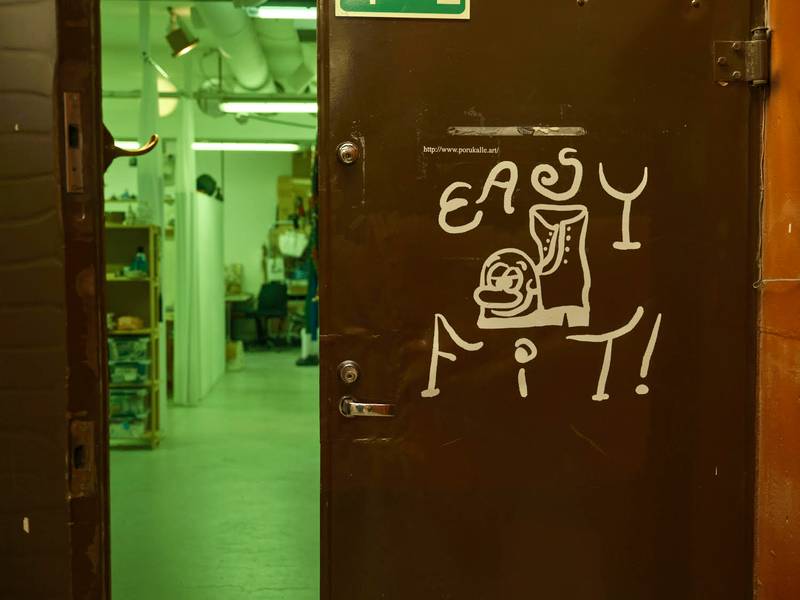

Easy Fit! exhibition was held at PORUKALLE, an open-ended artist studio located in Helsinki. The exhibition took place in August 2021. Exhibition photography Bryan Saragosa.
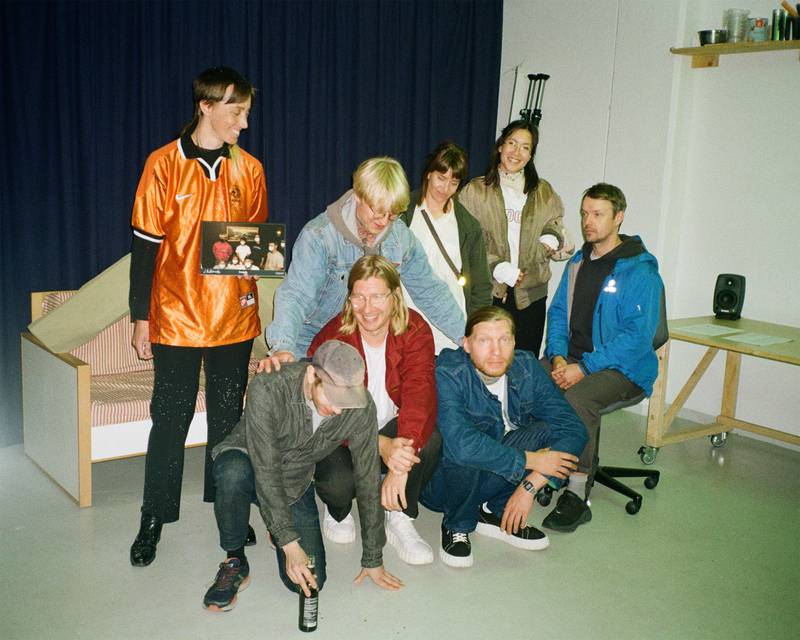

Special Day contribution by Jessie Bullivant, Imagine it’s a cool fancy old door with a splendid antique handle, 2021. In the picture: Jessie Bullivant and the folk of PORUKALLE, Hermanni Saarinen, Jussi Niskanen, Sakari Tervo, Juuso Tervo, Elina Vainio, Man Yau and Jaakko Pietiläinen. Special Day photography by Emma Sarpaniemi.
Can you tell me more about the Easy Fit! Exhibition, and how your group succeeded in making it happen? I cannot wait to see it.
I share an artist studio in Sörnäinen with six other artists: Elina Vainio, Sakari Tervo, Juuso Tervo, Jussi Niskanen, Hermanni Saarinen and Jaakko Pietiläinen. Easy Fit! is a studio-wide exhibition which focuses on the studio as a site, and themes of togetherness and unfinished work. The aim is to present artworks amid the processes themselves – away from the white cube and the typical polished, neutral gallery space.
The exhibition will include works from each of us placed in our working environment alongside an event called Special Day (22nd August) where invited artists will present performances on the themes of the exhibition.
The idea to organise the exhibition started approximately two years ago. We have been doing a lot of things together since. For instance, Elina has taught us how to dye textiles with natural dyes; I have held clay courses, and we have organised a studio sale. I feel that a sense of community and togetherness almost accidentally emerged, where we’re all united by art, but it almost also becomes secondary. And here I don’t mean making art as a hobby, but rather looking at artmaking from a perspective of empathy and the everyday. I think it’s really important that making art is not just a matter of presenting a finished piece of work. We felt that it was necessary to also bring out everything that happens between the idea and the final piece.
We decided to do everything related to this exhibition here in the studio, in-house style. For example, everything from the finance to the code for the website has been produced here in the studio. It has been a lot of work, but it doesn’t matter when you work with a wonderful team.
And finally, was there a comment or feedback that stayed with you from your exhibitions [M.Y. Chinoiserie at Kuvan Kevät/Exhibition Laboratory, 2021; Dried flowers last forever at Boy Konsthall, 2021]?
Well, I heard several comments that the Kuvan Kevät exhibition was “very strange” or “intense and hard to describe in words”. I don’t know if that’s a good or bad thing, but for me, it’s important that the work has left the viewer wondering.
That is so interesting; I agree that your works definitely stay in the mind. I will be looking forward to EasyFit! and following your future projects! This has been absolutely wonderful Man, thank you for your time.
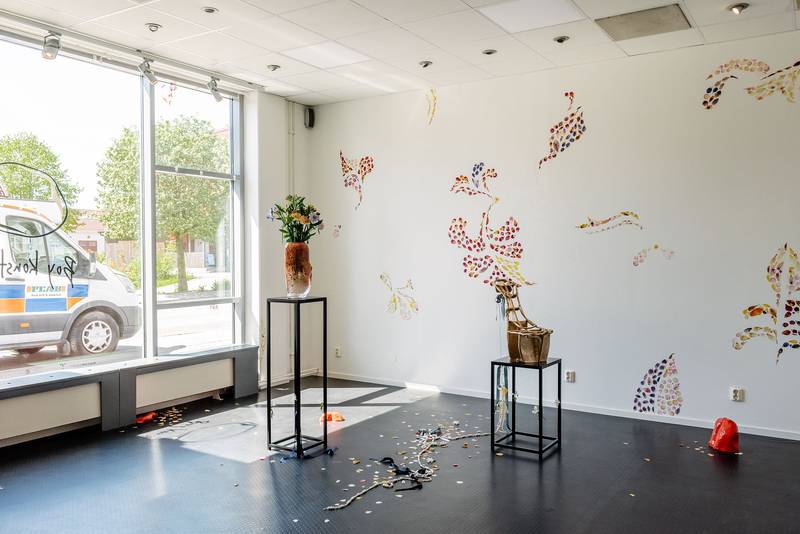

Man Yau, Installation view of Dried flowers last forever, 2021, at Boy Konsthall, Bollebygd, Sweden. Photo: AnnaCarin Isaksson.
